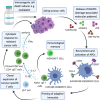Tumour immune microenvironment biomarkers predicting cytotoxic chemotherapy efficacy in colorectal cancer
- PMID: 33753562
- PMCID: PMC8461409
- DOI: 10.1136/jclinpath-2020-207309
Tumour immune microenvironment biomarkers predicting cytotoxic chemotherapy efficacy in colorectal cancer
Abstract
The role of the local tumour and stromal immune landscape is increasingly recognised to be important in cancer development, progression and response to therapy. The composition, function, spatial orientation and gene expression profile of the infiltrate of the innate and adaptive immune system at the tumour and surrounding tissue has an established prognostic role in colorectal cancer (CRC). Multiple studies have confirmed that a tumour immune microenvironment (TIME) reflective of a type 1 adaptive immune response is associated with improved prognosis. There have been significant efforts to evolve these observations into validated, histopathology-based prognostic biomarkers, such as the Immunoscore. However, the clinical need lies much more in the development of predictive, not prognostic, biomarkers which have the potential to improve patient outcomes. This is particularly pertinent to help guide cytotoxic chemotherapy use in CRC, which remains the standard of care. Cytotoxic chemotherapy has recognised immunomodulatory activity distinct from its antimitotic effects, including mechanisms such as immunogenic cell death (ICD) and induction/inhibition of key immune players. Response to chemotherapy may differ with regard to molecular subtype of CRC, which are strongly associated with immune phenotypes. Thus, immune markers are potentially useful, though under-reported, predictive biomarkers. In this review, we discuss the impact of the TIME on response to cytotoxic chemotherapy in CRC, with a focus on baseline immune markers, and associated genomic and transcriptomic signatures.
Keywords: biomarkers; colorectal neoplasms; immunohistochemistry; lymphocytes; stromal cells; tumour.
© Author(s) (or their employer(s)) 2021. Re-use permitted under CC BY-NC. No commercial re-use. See rights and permissions. Published by BMJ.
Conflict of interest statement
Competing interests: None declared.
Figures



Similar articles
-
The Expression of Immune Checkpoint Receptors and Ligands in the Colorectal Cancer Tumor Microenvironment.Anticancer Res. 2021 Oct;41(10):4895-4905. doi: 10.21873/anticanres.15303. Anticancer Res. 2021. PMID: 34593437
-
Cytolytic Activity Score to Assess Anticancer Immunity in Colorectal Cancer.Ann Surg Oncol. 2018 Aug;25(8):2323-2331. doi: 10.1245/s10434-018-6506-6. Epub 2018 May 16. Ann Surg Oncol. 2018. PMID: 29770915 Free PMC article.
-
Cancer Immunotherapies: From Efficacy to Resistance Mechanisms - Not Only Checkpoint Matters.Front Immunol. 2021 Jul 21;12:690112. doi: 10.3389/fimmu.2021.690112. eCollection 2021. Front Immunol. 2021. PMID: 34367148 Free PMC article. Review.
-
Analysis of Spatial Organization of Suppressive Myeloid Cells and Effector T Cells in Colorectal Cancer-A Potential Tool for Discovering Prognostic Biomarkers in Clinical Research.Front Immunol. 2020 Oct 29;11:550250. doi: 10.3389/fimmu.2020.550250. eCollection 2020. Front Immunol. 2020. PMID: 33193316 Free PMC article.
-
Colorectal Cancer Immune Infiltrates: Significance in Patient Prognosis and Immunotherapeutic Efficacy.Front Immunol. 2020 May 28;11:1052. doi: 10.3389/fimmu.2020.01052. eCollection 2020. Front Immunol. 2020. PMID: 32547556 Free PMC article. Review.
Cited by
-
Microenvironment, systemic inflammatory response and tumor markers considering consensus molecular subtypes of colorectal cancer.Pathol Oncol Res. 2024 Apr 5;30:1611574. doi: 10.3389/pore.2024.1611574. eCollection 2024. Pathol Oncol Res. 2024. PMID: 38645565 Free PMC article.
-
Heterogeneous immune landscapes and macrophage dynamics in primary and lung metastatic adenoid cystic carcinoma of the head and neck.Front Immunol. 2024 Dec 4;15:1483887. doi: 10.3389/fimmu.2024.1483887. eCollection 2024. Front Immunol. 2024. PMID: 39697346 Free PMC article.
-
Editorial: Chemo-Resistance in Gastrointestinal Cancers.Front Oncol. 2022 Jan 28;12:821212. doi: 10.3389/fonc.2022.821212. eCollection 2022. Front Oncol. 2022. PMID: 35155256 Free PMC article. No abstract available.
-
PTOV1 facilitates colorectal cancer cell proliferation through activating AKT1 signaling pathway.Heliyon. 2024 Aug 10;10(16):e36017. doi: 10.1016/j.heliyon.2024.e36017. eCollection 2024 Aug 30. Heliyon. 2024. PMID: 39229496 Free PMC article.
-
Association of immune-related expression profile with sensitivity to chemotherapy in esophageal squamous cell carcinoma.Cancer Sci. 2023 Nov;114(11):4459-4474. doi: 10.1111/cas.15942. Epub 2023 Sep 15. Cancer Sci. 2023. PMID: 37715346 Free PMC article.
References
Publication types
MeSH terms
Substances
LinkOut - more resources
Full Text Sources
Other Literature Sources
Medical
